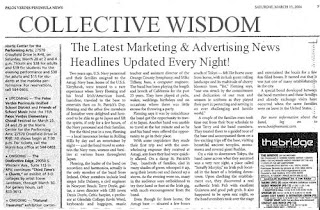The Wall Street Journal reports on a trend I have seen in my town for the past couple of years already:
As mall and shopping-center owners lose tenants in the souring economy, they are at least gaining something else: more advertising space.
![[Mall ads]](https://lh3.googleusercontent.com/blogger_img_proxy/AEn0k_sJIIUOUkm1EQZJaE_9VdRbWtzoE1xXjBm8P5GwaTvypbCPKWLPs0u6DUV6PbQR0zVIh33icItdnD9E-7VSbuFR-nOSvCtzwyN8zXgDFqGG2Uml8VXt_wjr0W9iw1M6g53stHyyo2A5fDVtbRHQs9Eh=s0-d) Inwindow Outdoor
Inwindow OutdoorAn Inwindow Outdoor ad display on West 34th Street in New York City late last year.
Upstart companies have cinched deals in recent weeks to plaster ads across the growing number of vacant storefronts in U.S. malls and shopping centers. Ads also are multiplying in unconventional venues such as food-court table tops, parking-space divider lines and security vehicles.
Rotten times for retail landlords have added momentum to the emerging industry of in-mall advertising. Vacant storefronts are one of the fastest-growing ad venues. Vacancy rates at malls and shopping centers this year have hit their highest levels in at least seven years, and vacancies likely will increase next year, according to real-estate research firm Reis Inc. Among the retailers closing stores across the country are chains Linens 'n Things Inc., Wilson's the Leather Experts Inc. and Whitehall Jewelers Holdings Inc.
Amid mounting store closures and retailer bankruptcy filings, opportunistic ventures are offering mall owners a method to derive revenue from the empty spaces. Founded in 2005 by Boston entrepreneur Adam Dell, WindowGain Inc. sets up multiple projectors inside a vacant store to shine images out onto the store's exterior windows. The projectors allow WindowGain to cycle through as many as six 10-second video advertisements on a single surface to catch the attention of passersby.
Inwindow Outdoor LLC, started in 2002 by New York Internet entrepreneur Steve Birnhak, takes the more static approach of stretching high-definition vinyl overlays across the surface of exterior windows to hawk anything from Red Bull GmbH energy drinks to Delta Air Lines Inc. flights to LG Electronics Inc. televisions.
Both companies still are relatively new, but they are gaining converts. Inwindow this month struck deals to put its ads on vacant stores in more than 50 malls and shopping centers owned by retail-property heavyweights General Growth Properties Inc., Westfield Group and Developers Diversified Realty Corp. WindowGain has installed its ad displays at General Growth malls in Boston and Providence, R.I., and at Boston Properties Inc.'s Shops at Prudential Center in Boston.
The proposition has little, if any, downside for landlords. Inwindow pays landlords a flat monthly rate of $1,000 to $8,000, depending on the ad's size and foot traffic passing the site, executives say. WindowGain pays $2,500 to $8,500 a month, plus 10% to 30% of the rates paid by advertisers including Comcast Corp., SABMiller PLC and Verizon Wireless.
The only concern, mall owners say, is that advertisers usually want the certainty of a 30- or 60-day contract, and landlords might want to cut that short if a new tenant comes calling.
Absent that, a little revenue is better than none. Developers Diversified would rather have tenants in its vacant spaces, but "we recognize this [ad program] as potential for six-figure revenue year after year," said Marc Feldman, vice president of new-business development. Analysts expect Developers Diversified to report roughly $915 million in revenue this year.
What's more, the ads mask unsightly gaps in a mall's storefronts. "It enlivens a space that's dead," Inwindow's Mr. Birnhak said.
To be sure, the revenue that mall owners gain from selling such ads will replace only a fraction of the rent lost from departing retailers. For example, advertising and sponsorship revenue has increased by almost 50% in the past four years for Glimcher Realty Trust, the Columbus, Ohio-based owner of 26 malls. But that revenue, combined with short-term seasonal leases, still amounts to only 3% of Glimcher's overall tally.
In-mall advertising isn't a new phenomenon, but it has been viewed as mostly a side venture. Mall and shopping-center owners have marketed themselves to advertisers as a more effective alternative to traditional media.
For example, Simon Property Group Inc., the largest U.S. mall owner by number of properties with more than 300 malls, touts that the average visitor to its malls spends 78 to 84 minutes per visit. And they aren't ignoring ads as they would while watching TV. "They're predisposed to buy, and they're predisposed to explore," said Mikael Thygesen, Simon's chief marketing officer.
To capitalize on that, mall owners have found several inventive ways to place ads in their properties, allowing the landlord to gain additional revenue or defray costs.
Glimcher has allowed an Internet company to apply neon-green, adhesive ads that cover the tops of tables in its food courts at a Newark, Ohio, mall. At Glimcher's Polaris Fashion Place in Columbus, a local Honda dealership provides two sport-utility vehicles emblazoned with its logo for use by Glimcher's security force, and employees of the mall's valet service wear shirts sporting the dealership's name. At other Glimcher malls, ads for insurance companies are glued to the painted lines separating parking spaces.
Write to Kris Hudson at kris.hudson@wsj.com
Sphere: Related Content













